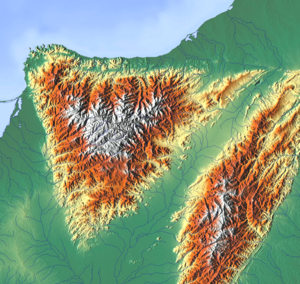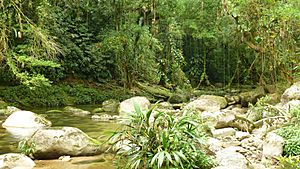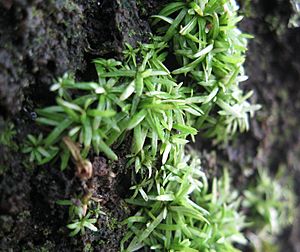Santa Marta montane forests facts for kids
Quick facts for kids Santa Marta montane forests (NT0159) |
|
|---|---|

Cerro Murillo
|
|
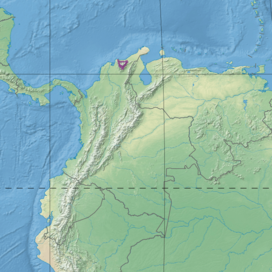
Ecoregion territory (in purple)
|
|
| Ecology | |
| Realm | Neotropical |
| Biome | Tropical and subtropical moist broadleaf forests |
| Geography | |
| Area | 4,920 km2 (1,900 sq mi) |
| Countries | Colombia |
| Coordinates | 10°31′55″N 73°37′01″W / 10.532°N 73.617°W |
| Climate type | Cwb: warm temperate, winter dry, warm summer. |
The Santa Marta montane forests (NT0159) is a special natural area, or ecoregion. It's found in the Sierra Nevada de Santa Marta mountains, which are a huge group of peaks right on the Caribbean coast in northern Colombia.
This ecoregion stretches from almost sea level up to about 3,300 meters (10,827 feet) high. At its highest points, it changes into a different type of land called Santa Marta páramo. Because these mountains are so isolated and have many different heights and climates, they are home to a huge variety of plants and animals. Many of these species are found nowhere else on Earth.
The lower parts of these forests used to be tropical rainforests. Sadly, most of these have been cut down. Higher up, you find cloud forests. A lot of these have also been cleared to grow coffee, create pastures for sheep and cattle, and for farming.
Contents
Exploring the Santa Marta Forests
Where are the Santa Marta Forests?
This ecoregion covers the slopes of the Sierra Nevada de Santa Marta in northern Colombia. It spans an area of about 492,097 hectares (1.2 million acres). These mountains rise to snow-covered peaks, even though they are only about 60 kilometers (37 miles) from the Caribbean Sea.
The Santa Marta montane forests are almost completely surrounded by the Sinú Valley dry forests ecoregion. To the northeast and northwest, they blend into the Guajira–Barranquilla xeric scrub, which is a dry, scrubby area. At the very top of the mountains, this ecoregion gives way to the Santa Marta páramo.
Mountain Landscape and Rocks
The Sierra Nevada de Santa Marta mountains are shaped like a triangle. They cover about 12,230 square kilometers (4,722 square miles). The highest peaks reach 5,775 meters (18,947 feet) and are always covered in snow. The northern side of the mountains runs along the Caribbean coast.
The southwestern side slopes down to the dry, warm plains of the Magdalena River. It also meets the Ciénaga Grande de Santa Marta marshes. The southeastern side touches the valleys of the Cesar River and Ranchería River.
The mountains are made of volcanic rocks from ancient times, between 252 and 2.58 million years ago. These rocks include granite and diorite. There are also areas with sedimentary rocks, which are formed from layers of sand and mud. The mountains were pushed up to their current height more recently, between 23 million and 11,700 years ago. Many of the main rivers in the area start from glacial lakes high up in the mountains, above 3,000 meters (9,843 feet).
Climate and Weather
The average air temperature changes a lot from the bottom to the top of the mountains. In the plains, it can be around 27°C (81°F). But in the snowy peaks, it's 6°C (43°F) or even colder. Rain is brought by winds from the northeast. The wet seasons are from September to December and from May to July.
The northern side of the mountains gets the most rain. It can receive up to 3,000 millimeters (118 inches) of rain each year at heights between 1,000 and 1,500 meters (3,281 to 4,921 feet). Higher up and to the south, there is less rain. The climate here is generally warm temperate with dry winters and warm summers. The average temperatures range from 11.4°C (52.5°F) in January to 13.8°C (56.8°F) in June. The total yearly rainfall is about 1,800 millimeters (71 inches).
Amazing Nature and Wildlife
This ecoregion is part of the Neotropical realm, which means it's in the natural region of Central and South America. It's also a type of tropical and subtropical moist broadleaf forests. Because it's isolated and surrounded by dry forests, many unique plants and animals have grown here. It's like a special island of nature, different from the Andes mountains.
However, it does share some similarities with the Serranía del Perijá mountains to the east. For example, 76% of the bird species in Perijá are also found in the Sierra Nevada de Santa Marta. Also, 80% of certain butterfly families in Perijá are shared with the Sierra Nevada.
Wonderful Plant Life (Flora)
On the north and part of the west side of the mountains, there are warm, wet forests. These tropical rainforests grow at heights up to 900 meters (2,953 feet). Their trees can reach 35 meters (115 feet) tall, depending on how much rain they get. The plants growing under the trees include tree ferns and grasses with big leaves. While there are some unique species here, the variety isn't as high as in other tropical regions.
On the drier western side, forests at heights from 800 to 1,000 meters (2,625 to 3,281 feet) have large trees. These include the Panama rubber tree (Castilla elastica) and avocado (Persea americana). Higher up, above 900 meters (2,953 feet), the trees and palms become smaller. You can find plants like spiny treeferns (Cyathea pungens). These forests also have plants that grow on other plants, like Vriesea elata, and mosses such as Octoblepharum albidum.
Cloud Forests and Their Plants
Above 1,000 meters (3,281 feet), you find cloud forests. The plants here are related to those in the tropical Andes mountains and higher parts of the Caribbean. These forests have many species found nowhere else. In some places, the cloud forest dips down to lower levels. The trees here can form a canopy 25 to 35 meters (82 to 115 feet) high.
Many different types of flowering plants grow here. The most common families include Asteraceae (like daisies), Orchidaceae (orchids), Fabaceae (peas and beans), and Rubiaceae (like coffee plants). Some plant groups, like Monochaetum and Tillandsia, each have five species that only live here. The Melastomataceae family has 13 unique species.
Andean royal palms (Dictyocaryum lamarckianum) stand tall above the cloud forest canopy. They are common from 900 to 1,600 meters (2,953 to 5,249 feet). The wax palm (Ceroxylon ceriferum) is common from 1,800 to 2,500 meters (5,906 to 8,202 feet). Other cloud forest trees include palo azul (Calatola costaricensis). The plants under the trees include tree ferns, palms, and woody lianas (vines). Many mosses and liverworts, like Dumortiera hirsuta, also thrive here.
Higher up, between 2,500 and 3,300 meters (8,202 to 10,827 feet), you find cloud forests that are 15 to 20 meters (49 to 66 feet) high. These areas have a lot of fog and mist, even though they get less rain than the lower slopes. Typical trees here include wax palm (Ceroxylon ceriferum) and Pino de Pasto (Podocarpus oleifolius). Many mosses and lichens, like bonfire moss (Funaria hygrometrica), also grow in these misty conditions.
Amazing Animal Life (Fauna)
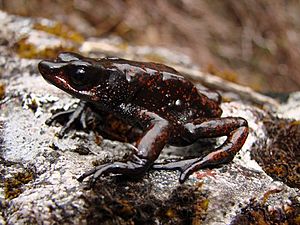
The Santa Marta forests are home to many different animals.
Mammals of the Mountains
Some mammals you might find here include the Central American agouti (Dasyprocta punctata), the powerful jaguar (Panthera onca), and the lowland paca (Cuniculus paca). You might also see the neotropical otter (Lontra longicaudis), the spotted ocelot (Leopardus pardalis), and the large South American tapir (Tapirus terrestris). The loud Venezuelan red howler (Alouatta seniculus) and the white-lipped peccary (Tayassu pecari) also live here.
Some mammals are found only in these mountains. These include the red-tailed squirrel (Sciurus granatensis) and the unicolored Oldfield mouse (Thomasomys monochromos). One very rare mammal is the red-crested tree-rat (Santamartamys rufodorsalis), which is endangered.
Birds of the Sky
Many beautiful birds live in these forests. Some examples are the bay-headed tanager (Tangara gyrola), the black-chested jay (Cyanocorax affinis), and the colorful keel-billed toucan (Ramphastos sulfuratus). You might also spot the Santa Marta blossomcrown (Anthocephala floriceps) or the white-tipped quetzal (Pharomachrus fulgidus).
Several birds have a very limited range and are mostly found here. These include the black-backed thornbill (Ramphomicron dorsale) and the unique green-bearded helmetcrest (Oxypogon guerinii). Birds found only in the Santa Marta mountains include the Santa Marta parakeet (Pyrrhura viridicata) and the white-tailed starfrontlet (Coeligena phalerata).
Some birds in this ecoregion are endangered. These include the majestic black-and-chestnut eagle (Spizaetus isidori), the blue-billed curassow (Crax alberti), and the Santa Marta wren (Troglodytes monticola).
Reptiles and Amphibians
The Santa Marta forests are also home to many different reptiles and amphibians. Some lizards found only here include the Colombian Clawed Gecko (Pseudogonatodes furvus) and the Santa Marta Anole (Anolis santamartae).
Amphibians include several types of Pristimantis frogs, especially at higher elevations. These include the Cebolleta Robber Frog (Pristimantis tayrona) and the Santa Marta robber frog (Pristimantis sanctaemartae). The only type of amphibian found only in the Sierra Nevada mountains is Walker's Sierra frog (Geobatrachus walkeri).
Many amphibians here are endangered. These include the Guajira stubfoot toad (Atelopus carrikeri), the Harlequin frog (Atelopus laetissimus), and the Santa Marta poison arrow frog (Colostethus ruthveni).
Protecting the Forests
The World Wide Fund for Nature (WWF) says that this region is "Vulnerable," meaning it's at risk. People have lived in these mountains since ancient times, long before Europeans arrived, and traces of their communities can still be seen. Parts of the ecoregion have been settled by people since the late 1800s.
Sadly, between 70% and 80% of the original forest has been cut down in the last 50 years. When forests are cleared, it causes soil erosion, which can lead to mudslides during rainy seasons. It also causes rivers to become filled with silt.
In the late 1800s, large areas of forest at middle elevations were turned into coffee farms. Big parts of the forest have also been cleared to create pastures for animals, which are kept clear by burning them each year. Higher up, areas of the cloud forest have been changed for raising sheep and cattle, growing potatoes and fruit, and cutting down wood.
Cutting down forests has put large animal populations at risk. Animals are also hunted for food, for their skins, or because people think they might harm cattle. New roads built into the higher areas have led to ancient sites being looted, more hunting, and more trees being cut for firewood.
A report from 2006 showed that about 33.4% of the Santa Marta montane forests had been changed by human activity. Some parts of the ecoregion are supposed to be protected by places like the Sierra Nevada de Santa Marta National Park and Tayrona National Natural Park. However, even in these protected areas, forests were still being cleared in 1998. The lands set aside for the Cogui, Arsario, and Arhuaco indigenous people also overlap with the Sierra Nevada de Santa Marta National Park.
|
See also
 In Spanish: Bosques montanos de Santa Marta para niños
In Spanish: Bosques montanos de Santa Marta para niños


